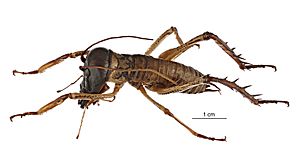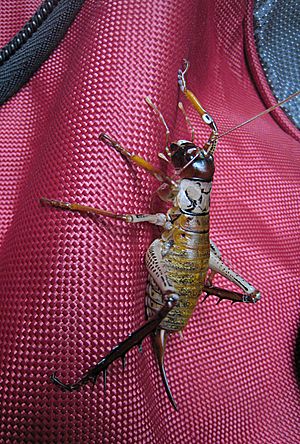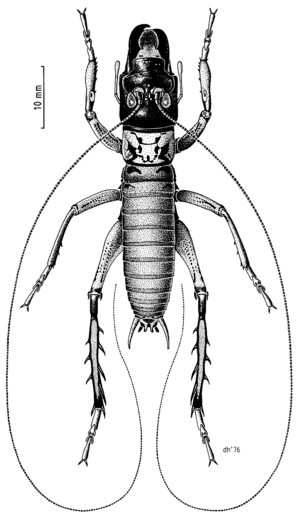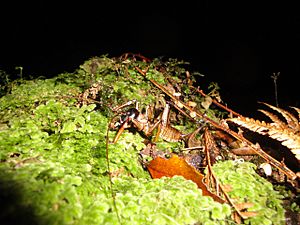Auckland tree weta facts for kids
Quick facts for kids Auckland tree weta |
|
|---|---|
 |
|
| Scientific classification | |
| Genus: |
Hemideina
|
| Species: |
thoracica
|
| Synonyms | |
|
|
The Hemideina thoracica, often called the Auckland tree wētā or tokoriro, is a cool insect. It looks a bit like a cricket. This wētā is special because it's only found in New Zealand. You can see it across most of the North Island. However, it doesn't live in the Wellington area or in places higher than 900 metres (about 3,000 feet) above sea level.
This wētā mostly lives in trees and eats plants. It can eat many different types of plants. You can find it in forests, scrublands, and even in gardens in towns.
Even though all Auckland tree wētā look quite similar, they can have different numbers of chromosomes. Scientists have found at least eight different groups based on their chromosomes. Sometimes, these groups meet and mix in special areas called "hybrid zones."
The Auckland tree wētā is closely related to other wētā species in the North Island. These include H. crassidens and H. trewicki. Good news! This wētā is generally "not threatened". But one special group, found on the Karikari Peninsula, is listed as "nationally vulnerable". This means it needs more protection.
Contents
Who Discovered the Auckland Tree Wētā?
The Hemideina thoracica was first described in 1846. A Scottish scientist named Adam White gave it its first name. Back then, he put it in a different group called Deinacrida. Later, in 1869, another scientist named Walker created the wētā group Hemideina. The Auckland tree wētā became the main example for this new group.
Where Do Auckland Tree Wētā Live?
The Auckland tree wētā is only found in New Zealand. It lives across the northern two-thirds of the North Island. You can find many of them in the central and northern parts of the North Island. They like forests and scrub areas at lower elevations.
These wētā are active at night. During the day, they hide in holes in trees. This keeps them safe and hidden. At night, they come out to find food. The Auckland tree wētā shares its home with two other Hemideina species. These are H. crassidens and H. trewicki. In warmer places, the Auckland tree wētā might even push out H. crassidens.
What Do Auckland Tree Wētā Eat?
Like other tree wētā, the Auckland tree wētā looks for food at night. They climb trees to find their meals. They mostly eat leaves, but they also enjoy some fruits and seeds. Scientists used to think they ate just about any plant. Now, they believe these wētā choose certain plants. For example, they really like Mahoe (Melicytus ramiflorus) and Karamu (Coprosma robusta).
Interestingly, Auckland tree wētā also eat small insects. This means they are not just plant-eaters. Wētā living in higher places tend to eat more insects. They also eat fewer types of plants than those living in lower areas.
What Do Auckland Tree Wētā Look Like?
Adult Hemideina thoracica are quite big. They can weigh 3 to 7 grams and grow up to 40mm long. Their main body is brown. The part behind their head (called the pronotum) is pale. It often has dark, hieroglyph-like patterns. This coloring helps tell them apart from the Wellington tree wētā (H. crassidens).
Like other Hemideina species, they have spikes on their back legs. These spikes help them defend themselves. Scientists have studied these spikes. They found that H. thoracica and H. crassidens are missing a specific spike. This helps tell them apart from other Hemideina species. The Auckland tree wētā also has the thinnest upper and lower leg parts (femur and tibia) compared to other New Zealand tree wētā.
Male and female Auckland tree wētā look different. This is called sexual dimorphism. Males have much bigger jaws (mandibles). They use these large jaws to fight other males.
How Are Their Chromosomes Different?
The Hemideina thoracica is special because its chromosomes can be different. This means different groups of this wētā can have different numbers of chromosomes. Scientists have found nine distinct chromosome groups. These groups have different numbers of chromosomes, from 11 to 23.
There are five areas where these different chromosome groups meet. These are called "hybrid zones." In these zones, different groups can mix. Some of these zones are in the north, like at Karikari. These northern groups likely formed a very long time ago. The southern groups, found in places like Bream Bay, are probably much younger. Even with these chromosome differences, the wētā still look very similar.
How Do Auckland Tree Wētā Behave?
Auckland tree wētā can make sounds! They do this by rubbing their back legs against their body. Both males and females make a harsh, rasping sound when they are bothered. They raise their legs and kick defensively.
Males also make a special song when they are close to each other. They do this by moving their abdomen. However, these wētā are not very good at recognizing their own mates. This means they can sometimes have babies with other wētā species. These babies are often unable to have their own young.
Since they are active at night, these wētā hide in tree holes during the day. How they choose these hiding spots can depend on the season. It also depends on who was in the hole before. Females often avoid holes where other females have been. They usually prefer to be alone. But in summer, this changes. Females and males that were living apart start living together.
How Do Auckland Tree Wētā Reproduce?
Scientists think that Auckland tree wētā mate with many partners. Both males and females might mate with different individuals. These insects grow through several stages. Their eggs hatch in the spring. They need at least eight growth stages before they become adults. Females lay their eggs in the soil. After laying the eggs, the mother wētā does not care for her young.
Are Auckland Tree Wētā Endangered?
Overall, the Hemideina thoracica is "not threatened". This is good news! However, one specific group of this wētā, found on the Karikari Peninsula, is listed as "nationally vulnerable". This means it is at risk and needs special attention.
Scientists have used fake shelters to keep an eye on wētā groups. These shelters could help protect these wētā species. They give the wētā safe places to live.








